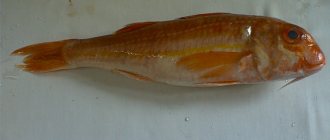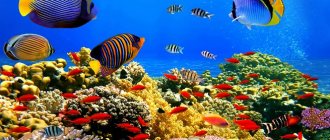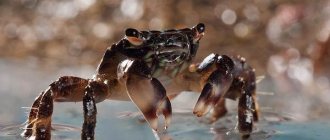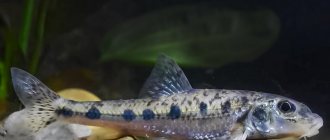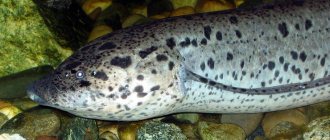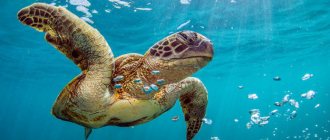Water quickly scatters sunlight, so even at a depth of 100 meters the seas and oceans are pitch dark. To somehow navigate in space, many deep-sea creatures resort to so-called bioluminescence - the ability of living organisms to glow in the dark. However, American scientists recently discovered that next to these luminous creatures there are also fish that use darkness as camouflage. Their bodies are covered with cells that literally absorb any light rays - one might say that there are “black holes” floating deep under military and fishing ships. And they need camouflage to sneak up on potential victims and suddenly attack them. In general, at great depths there is a severe struggle for survival.
There are fish on our planet that absorb light
Bioluminescence is a phenomenon in which fish, bacteria and other living organisms glow due to processes occurring within their bodies. You can read more about this in the article by Ilya Khel.
Commercial fish of the Black Sea
Commercial fish in the Black Sea are caught annually in the amount of about 23 thousand tons. Of these, almost 17 thousand are small species:
1. Tulka. Belongs to the herring family. In addition to the Black Sea, the species lives in the Caspian and Azov seas. The fish is distinguished by a short and wide head, a dark green back combined with silvery sides and belly.
The weight of one sprat is about 30 grams with an average body length of 12-14 centimeters. The fish meat is tender and famous for its balanced composition. It contains a lot of unsaturated fatty acids, B vitamins, and microelements.
2. Bulls. These fish of the Black Sea are immortalized in metal. The monument stands in Berdyansk. This is a city in the Zaporozhye region of Ukraine. The fish cast in bronze symbolizes the breadwinner of the local population, the main commercial species.
Its representatives have a large head that is one third of the body size. The latter suddenly takes courage. Several types of gobies are combined under the collective name. The largest martovych reaches 1.5 kilograms of weight.
However, most bulls do not exceed 200 grams and are approximately 20 centimeters in length. But the fish of this category are common, make up the lion's share of the catch, and are edible. This means you won’t die of hunger.
3. Sprat. The fish has a blue-green back and silvery sides with a belly. The animal is distinguished by a single dorsal fin, shifted to the caudal fin, a large mouth and large eyes. For people who do not understand the types of fish, sprat is similar to sprat and anchovy.
However, monuments to them have been erected abroad. Sprat is immortalized in the Russian city of Mamonovo. There is a marble table with a metal can. There are sprats in it. One of the fish has a crown on its head. This reflects the commercial importance of the species.
4. Hamsa. Otherwise called gavros. Fish living in the Black Sea have an elongated, slender body up to 17 centimeters long and weighing approximately 25 grams. The animal has a large mouth, blue-black back and silvery sides.
Externally, anchovy is similar to sprat, sprat, sprat, but has more tender meat. A quarter kilo per day is enough to satisfy the daily need for valuable acids such as methionine, taurine, tryptophan.
5. Sprat. It belongs to the herring family and has spiny scales on its belly. They form the keel. Its pointed line adds streamlining to the sprat and makes it invisible when viewed from the depths. The fish in the Black Sea has an average length of 10 centimeters and weighs approximately 20 grams.
Sprat live in flocks and are found not only in the Black Sea. Off the coast of England, for example, fish were caught in excess of food requirements, and were also used to fertilize fields. This was the situation in the 19th century. In the 21st, the number of sprat is decreasing.
6. Mullet. The fish is distinguished by the location of the nose and dorsal fin on the same line. This is a consequence of the flattened back of the animal. It has a gray torpedo-shaped body. Mullet annually contributes to the commercial fish species of the Black Sea
Each fish has an elongated head with a pointed nose. The animal's mouth is small and lacks teeth. There are individuals weighing up to 7 kilograms. However, most fish weigh around 300 grams.
7. Pelengas. It has a torpedo-shaped body with rough, large scales that even cover its head. The color of the plates is brownish with a single black dot on each scale. There is a leathery fold behind the edge of the pelengas mouth, and there is a fatty eyelid on the eyes.
The fish reaches 60 centimeters in length and can weigh up to 3 kilograms. About 200 tons are caught annually.
8. Sea rooster. Belongs to perciformes. There are many types of sea roosters. One lives in the Black Sea. The fish reaches 35 centimeters in length. Outside the reservoir there are half-meter roosters.
The name is associated with the bright color of the fins. The pectorals have sharp needles, 3 on each. By plunging its fins into the sand, the fish picks up small prey, as if on skewers. However, a large mouth allows roosters to hunt large fish.
Although unattractive in appearance, animals with bright fins are distinguished by their taste and are served in restaurants.
Several commercial fish in the reservoir are classified as semi-anadromous. These grow in the area of river mouths, in the coastal strip of the sea. To spawn, fish rush to the lower reaches of rivers. We're talking about:
- pike perch, which belongs to the perch family and has transverse stripes on its elongated body
- bream, classified as a carp and having a high, laterally compressed body
- ram, which is similar to a roach, but larger, reaches a length of 38 centimeters and can weigh 1.5 kilos
- Miron-barbel, gaining mass of about 10 kilos with a length of 80 centimeters, several of which are mustaches on the upper lip of the animal
No more than 300 tons of anadromous species are harvested from the reservoir per year. Fishing in the Black Sea thus accounts for approximately 1.3% of total production.
About 1 thousand tons of valuable fish are caught in the Black Sea per year. The catch has been reduced due to a number of restrictions and bans. Fish included in the Red Book are not caught on an industrial scale. Of those whose numbers are still stable, we list:
1. Swordfish. It belongs to the perciformes, has an elongated bony nose, which in fact is an upper lip. The predatory fish of the Black Sea literally pierce their prey. However, sometimes the sword noses stick into inanimate obstacles, for example, boats.
This “anchor” can be 4 meters long and weigh 500 kilograms. In the Black Sea, swordfish appear during migrations from tropical ocean waters. Therefore, the catch is limited and insignificant.
2. Pelamida. It belongs to the mackerel family, differing in the same fatty, white meat. The schooling predator reaches a meter in length and weighs approximately 9 kilos. The bonito enters the Black Sea through the Bosphorus.
If mackerel does not spawn in Russian waters, its relative remains to reproduce. However, in the fall, bonito flock back to the Bosphorus.
3. Bluefish. These Black Sea fish are inconspicuous in the photo, but they are related to tuna, having the same delicious meat. The fish is large, stretches 115 centimeters, weighs about 15 kilograms.
The predator's body is flattened laterally and tall. The bluefish's large mouth is lined with sharp teeth.
4. Brown trout. Represents salmon in the reservoir, otherwise called trout. In the Black Sea, the fish is migratory, reaches a meter in length and weighs 10-13 kilograms. Freshwater forms of trout are 2-3 times smaller. All salmon have red, delicious meat.
5. Katran. The names of the fish of the Black Sea included a shark. Katran does not exceed 2 meters in length and 15 kilos in weight, does not pose a danger to people, but is tasty. The white meat of the fish is light and tender.
Due to fishing, the species' numbers are declining. The issue of adding the katran to the list of protected fish is being decided.
6. Flounder. Usually small in stores. However, giants over 4 meters long are also caught. The weight of such fish exceeds 300 kilograms. But, this is outside the Black Sea.
In it, the largest species of flounder called kalkan stretches to a maximum of 70 centimeters and can weigh up to 17 kilos.
7. Sargan. The animal's body resembles an arrow in shape. Its length is approximately 70 centimeters. The fish has an elongated upper jaw and, in general, a head. The mouth is lined with sharp teeth. This is a sign of a predator. The main prey is anchovy.
The back of the garfish is green, and the sides and belly are silver. White fish meat, dietary. Those unfamiliar with garfish are confused by the green color of the animal’s spine. However, there is no poison in the bones.
8. Herring. The high culinary properties of fish are “overshadowed” by its inability to maintain freshness. This is why herring is salted and smoked. Fresh fish ends up only on the tables of fishermen from coastal settlements.
There they “created” confusion in the understanding that the species being described exists. In fact, this is a family of herring fish. However, fishermen also call sprat. Juvenile herring are called herring. Specially salted fish is called anchovy.
And scientists call this a separate family that is not related to herrings. Be that as it may, there is a true herring. It is approximately 40 centimeters long, has fatty, tasty meat, a rounded and elongated body with silvery scales, darkened on the back.
This is the kind of fish that is found in the Black Sea and ends up in shops and restaurants. However, there are species that are sometimes caught on fishing rods and in the nets of the local population, but have no commercial significance.
Pelengas
Pelengas is a fish from the mullet family, native to the Far East. The pelengas were moved to the waters of the Azov Sea in the 60s and successfully took root there, and later settled in the Black Sea. Pelengas is a medium-sized fish from the Black Sea and very similar to carp. It's inexpensive and very tasty. Excellent fried and baked for main courses. You can also try fish soup from pelengas.
Fishes of the Black Sea that have no commercial significance
Like commercial species, species that are not of industrial importance rarely live below the 200-meter mark. There, in the Black Sea, a layer saturated with hydrogen sulfide begins. The environment is unsuitable for life.
Fish of the reservoir that do not have commercial significance include:
1. Blenny. Belongs to perciformes. The length of the fish ranges from 20 centimeters to half a meter. In the Black Sea there are no individuals larger than 30 centimeters. There are leathery folds at the corners of the mouth.
When the dog suddenly opens its mouth, they stretch. It turns out to be a giant mouth that captures and sucks in prey. The fish catches it by hiding among the rocks of the bottom. The dogs are edible, but their taste is mediocre, and they are also bony.
2. Sea ruff. It is a maximum of 30 centimeters. The species is distinguished by its ability to change color. It ranges from brown to yellow to red. The ruff can also change its skin by getting lost on stones.
Under the skin is tasty, soft white meat. However, due to its small size, solitary lifestyle and bonyness, the species is not considered a commercial species.
3. Needles. These fish, 60 centimeters long, weigh no more than 10 grams each. There is, as they say, nothing to eat. The width of the needle body is about the width of a pencil. The color of the animal is brown in order to camouflage itself in thickets of underwater vegetation.
The name "needles" is collective. In particular, the category includes 20-centimeter skates, shaped like chess pieces.
4. Astrologers. There are 15 types of them. There is only one living in the Black Sea. He has a flat head with large eyes close to the center. They look up as the fish burrows into the sand. This is done to wait for prey. From the outside it seems that the fish is watching the stars. The animal has tasty, dietary meat.
Why is the stargazer not included in the commercial species? The gill covers of the fish have sharp, poisonous spines. The puncture sites are very painful and swollen. That's why fishermen avoid stargazers.
poisonous fish of the Black Sea a serious threat to health . Even if you eat stargazer gill spines, which people don’t tend to do, you will “get” food poisoning at most. There are more serious threats in the Black Sea. More about them in the next chapter.
Black Sea garfish
The Black Sea garfish looks very similar to the needle fish. The garfish has a long body and a sharp beak-like nose. There is so much phosphorus in this fish that it glows in the dark, and its bones also glow green.
In Adler there is even a restaurant with the same name, where, in addition to garfish, you will be served red mullet and bluefish, horse mackerel and flounder, katran and trout.
Sargan will be served fried or boiled, but you should keep in mind that this fish from the Black Sea has a specific taste that not everyone likes.
Poisonous fish of the Black Sea
Poisonous species are few in number in the Black Sea. In addition to the astrologer, the following are dangerous:
- a dragon reaching 40 centimeters in length and equipped with toxic spines located on the gills and head
- Stingray, which is a stingray, accustomed to burrow into the sand, leaving above it only a tail with a 35-centimeter needle filled with poison
- Black Sea scorpionfish, reaching 1.5 meters in length, having long supraocular tentacles and numerous poisonous outgrowths, needles on the body
These are fish in the Black Sea . Only stingray venom can lead to death, and only if the victim has problems with the heart or respiratory system. The venom of a large stingray can also kill a child or an old man without proper and timely medical care.
Dragons and scorpionfish sting, causing, in addition to itching and swelling of the wounds:
- temperature
- aching joints
- vomiting
- stool disorders
- dizziness
The Black Sea scorpionfish can sometimes be found in shallow water, not far from the shore, but more often it lives at a depth of more than 50 meters. Therefore, meeting a toxic sea resident is unlikely. It is worth looking out for stingrays and dragons near the shore. The stingray needle is hardly noticeable among the sand. The little dragon resembles an ordinary goby - a commercial species. It's confusing.
red mullet
Red mullet is perhaps the most famous fish of the Black Sea. This is a small fish, slightly larger than sprat, and they eat it almost entirely, leaving only the head. Some even eat the head. The bones are small and soft.
Red mullet has a delicate taste and is considered a delicacy. Its meat has an exceptional taste. Red mullet contains a special fat - it is very tender, has a unique taste and has a wonderful aroma. Red mullet is often called sultanka, since it used to be served on the table of emperors and sultans.
Red mullet is often deep-fried. This is more of a first course, a salad replacement or a beer snack, an excellent option for an afternoon snack. It is on the menu of almost all cafes in Sochi, and there are many offers on the embankment.
Red mullet can also be fried or baked. So, in the Greek version, red mullet is cooked in the oven.
Fauna on land
Facts about the animals of the Black Sea coast that live on land cannot be contained within one article. In coastal forests you can find representatives of the order of predators: fox, jackal, lynx, bear, etc. Of the herbivores, the largest population is deer, roe deer, and hares. Wild boars, otters and bats are common here. There are many representatives of the bird kingdom: hawks, black grouse, pheasants, jays, crows, etc. Naturally, there are also waterfowl. These are seagulls, cormorants, diving ducks, swans, etc. They hunt small fish and other marine life.
Composition and beneficial properties
Black cod is beneficial for humans because it contains a large amount of Omega-3 acid complex. Such substances are antioxidants; they strengthen cell membranes and prolong their life.
Nutritionists say that it is not reasonable to say that coal fish brings only benefits, because it is very fatty. It is superior in calories to beef, so its consumption will not be beneficial for everyone.
The pulp of this fish will be useful for people with hypertension, kidney and heart failure. What these diseases have in common is that they provoke swelling, and the potassium contained in the composition flushes out salts and helps the body cells get rid of excess fluid.
The composition contains iron, which is a source of hemoglobin necessary for humans. This fish will be useful for anemia, during the recovery period after childbirth, and for emotional and physical exhaustion. Can be included in the diet of athletes, children and the elderly.
